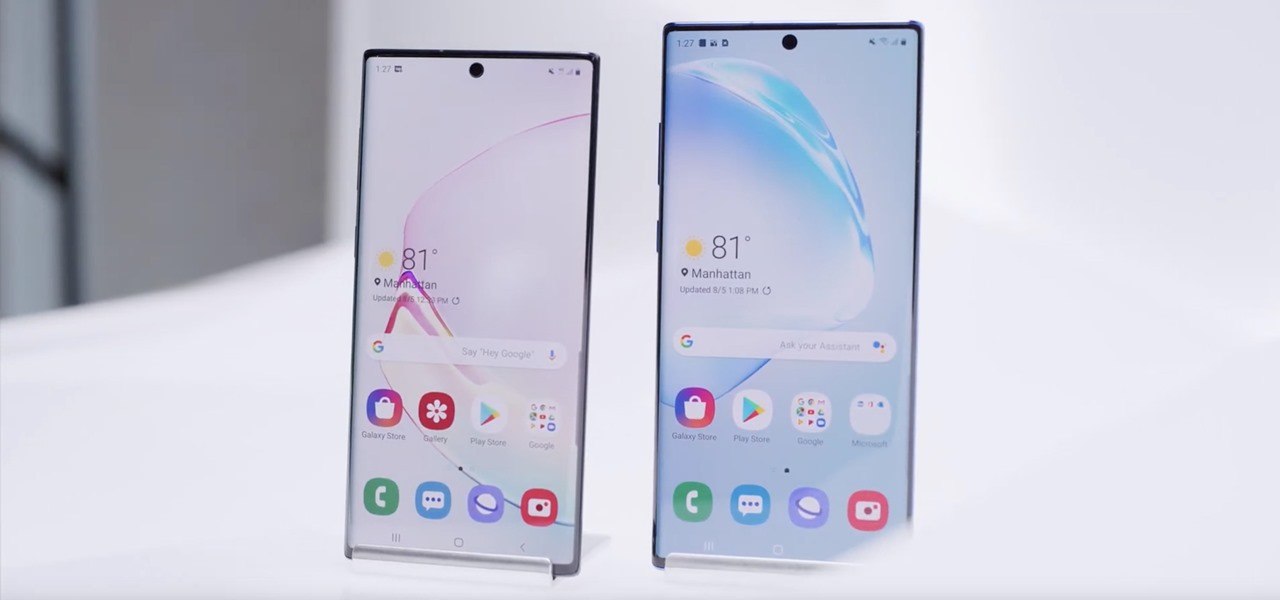Samsung has just announced the Galaxy Note 10 and 10+. These are the latest and greatest from the largest smartphone OEM in the world. Plenty of numbers and specs have been thrown your way to showcase how good the Galaxy Note 10 is, but we wanted to simplify all this for you and key in on the most important things.
So if you're lost in the hype that is the Samsung Unpacked 2019 event, we created a cheat sheet showing what's really new with the Galaxy Note 10 and Note 10+. This way, whether you are a Samsung fanboy (or fangirl), a tech enthusiast, or Samsung hater, you can join the conversation and decide if this is your next phone, or why you're even more excited for another phone release.
1. There Are 4 Variants This Time
For the last three years, we have seen Android OEMs change their flagship strategy to include more options in the lineup. It started with HTC back in 2017 when they released three flagships in the same year, and was followed by LG in 2018 when they released an outrageous number of V and G series phones.
2019 seems to be Samsung's turn, as they've already released four flagship phones in the first half of the year. For the second half of the year, we have four more, the Galaxy Note 10, Galaxy Note 10+, Galaxy Note 10 5G, and Galaxy Note 10+ 5G.
Similar to the S10 series, the phones are different in screen size, battery size, and cellular modem support. However, unlike the S10 series, the changes go further than screen size. Compared to the Galaxy Note 10, the Note 10+ has a higher screen resolution, faster processor, and more rear cameras. This gap is the reason for the low entry price of the Galaxy Note 10, making it one of the more affordable Galaxy Note phones to release in some time.
2. There Are 3 Different Processors
This year, Samsung is using three different SoCs in their devices. Depending on the model you get, your device may use either Qualcomm's Snapdragon 855 or Snapdragon 855+, or Samsung's Exynos 9825.
All Galaxy Note 10+ models use the Qualcomm Snapdragon 855+. This is the fastest SoC out of the bunch, as it overclocks the Qualcomm Snapdragon 855 by 4% on the CPU side and 15% on the GPU side. All Galaxy Note 10 variants except for Verizon's use the Samsung Exynos 9825. Verizon's version of the Galaxy Note 10 uses the Qualcomm Snapdragon 855, which is expected to outperform the Exynos model.
So if you're looking for the best processor, it goes like this: 1.) Any Note 10+, 2.) Most Note 10 models, 3.) The Verizon Note 10.
Aside from performance differences, which processor is used is important for another reason: rooting. Right now, Qualcomm-powered Samsung devices are not rootable, as the bootloader is locked. However, the Exynos-powered Samsung devices used in the rest of the world have unlockable bootloaders, which makes rooting and custom ROMs possible. This may not carry over to the North American Exynos Note 10 models, but it's an enticing possibility.
3. Charging Will Be So Much Faster
While Samsung excels in most areas when compared to other smartphone makers, one of their weak points has been charging. They've been releasing phones (including the Galaxy S10 series) with a fast charging technology based on Quick Charge 2.0. We are talking a 15 W charger that takes forever to charge modern devices, especially as they increase the size of the battery in their phones.
This is no longer an issue. The Galaxy Note 10 and 10+ come with a 25 W charger included in the box. If you want even faster charging, for an additional $60, you can get a 45 W charger.
But that's not all. Wireless charging also got upgraded. You can now use 20 W wireless chargers, a 5 W increase from the Galaxy S10. We are talking similar power outputs to some phones' wired fast-charging system, including Samsung's old technology.
Finally, reverse wireless charging (aka PowerShare), the feature introduced with the Galaxy S10 to charge other wireless devices using the phone 's battery, is returning. It will provide up to 15 W of power to charge these devices.
4. Fewer Cameras on the Front, More on the Back
The Galaxy S10+ introduced a second sensor to the front camera, a ToF sensor. ToF, or Time-of-flight, is a camera which can measure the distance between the camera, the subject, and the background. With this information, it can determine the depth of field, improving portrait style photography.
The Galaxy Note 10 and 10+ remove this sensor from the front and move it to the back. The rear cameras on the Galaxy Note 10 and 10+ include a standard wide lens, telephoto lens, an ultrawide lens, and a ToF sensor. The front camera is a single lens, but adds symmetry to the screen as it's placed right in the center.
5. No Headphone Jack
You read that right, Samsung has officially dropped the headphone jack from the Galaxy Note series. It appears this is the end of the audio port for all flagship Samsung devices, reducing the list of premium devices that still have the port to two (ASUS and LG).
The reason is always the same — bigger battery, space for additional components, etc. — but for many Samsung users, this will be a big kick in the gut. This is one of the main reasons why despite the Note 10 being newer, it might be worth upgrading to (or keeping) the Galaxy S10.
6. Upgraded S Pen
The S Pen received its most significant upgrade in years when Samsung added Bluetooth support with the Note 9. This meant controlling the screen remotely was now possible, paving the way for things like taking photos and controlling music. With the Note 10, this list is getting even more extensive thanks to "Air Actions." Samsung has opened the SDK developers so support will expand to more apps.
The S Pen is also even more precise thanks to 4,096 pressure levels and has a latency of 70 ms. The S Pen will also emit a sound when performing specific tasks.
7. Prices Range from Decent to EXPENSIVE
Now that there are three different major variants of the Note 10, pricing is all over the map. The base-tier Galaxy Note 10 starts at $949, while the Note 10+ starts at $1,049. Finally, the Galaxy Note 10+ 5G comes in at $1,299, but can get as high as $1,399 when maxed out.
Considering the base model Note 9 retailed for a cool grand this time last year, the $949 price tag on the Note 10 is a welcome change. But when you're spending 1,400 bucks on a phone like the 10+ 5G, your wallet's really gonna be feeling that one.
Who needs a wand? Unlock your magical powers and transform yourself from a Muggle into a Wizard or Witch just by using your Android phone. See how:




















Be the First to Comment
Share Your Thoughts